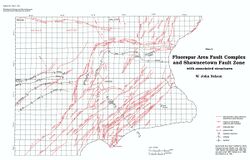Dixon Springs Graben
Part of the Fluorspar Area Fault Complex
Location
From northeastern Pope to Massac County (K-6, 7; pl. 2)
References
S. Weller and Krey 1939, J. Weller et al. 1952, Ross 1963, Heyl et al. 1965, Baxter et al. 1967, Kolata et al. 1981, Bertagne and Leising 1991, Weibel et al. 1993
Description
The Dixon Springs Graben is bounded by the Lusk Creek and Herod Fault Zones on the northwest and by the Hobbs Creek Fault Zone on the southeast. The southernmost Pennsylvanian rocks in lllinois are preserved within it. Drilling indicates that the graben extends beneath Cretaceous cover in the Mississippi Embayment and probably continues into Kentucky.
The Dixon Springs Graben apparently has undergone no fewer than five episodes of displacement. A seismic profile (Bertagne and Leising 1991) showing a thicker Cambrian section southeast of the Lusk Creek Fault Zone, implies normal faulting during Cambrian sedimentation. Additional normal displacements during the Morrowan and Atokan Epochs (Pennsylvanian) are indicated by thickness and facies relationships mapped in the Waltersburg Quadrangle (Weibel et al. 1993). Post-Pennsylvanian deformation first involved reverse faulting that raised the crustal block between the Lusk Creek and Raum Fault Zones, then normal faulting that lowered this block below its original position (Weibel et al. 1993). Finally, late Tertiary faulting in the southern part of the graben displaced units as young as the Mounds Gravel with apparent normal right- lateral slip (Nelson, unpublished mapping).
